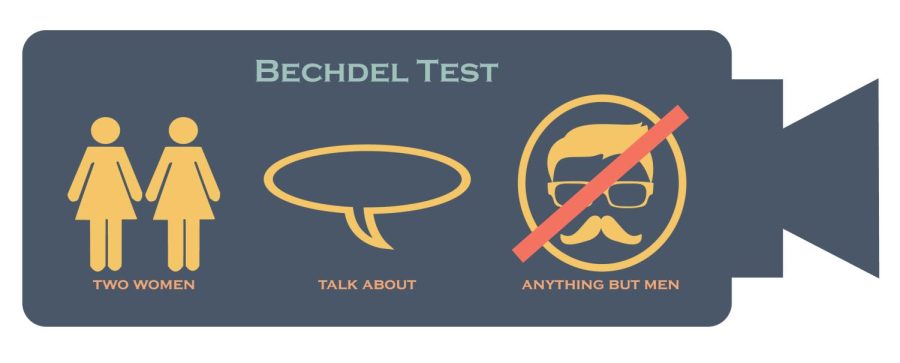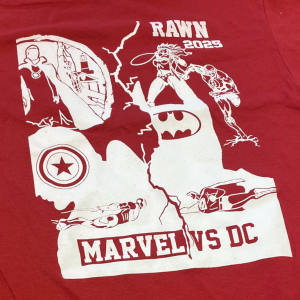Is the Bechdel-Wallace Test a fair measure of the representation of women in movies?
The 1985 test is supposed to examine how women are presented in the film, but few people know about it or its purpose
The “Bechdel test” asks whether a movie features at least two women who talk to each other about anything BESIDES a man.
May 6, 2022
For decades, women in popular media have been utilized as props or motivation for the main male protagonist. Popularized by Alison Bechdel’s 1985 comic “The Rule“, the Bechdel-Wallace test, commonly known as the Bechdel Test, is a measure of the representation of women in fiction based on three simple rules. “(1) it has to have at least two women in it, who (2) who talk to each other, about (3) something besides a man.”
The Bechdel Test takes things a step further from the simple act of having women in movies by evaluating the quality of the parts played by women.
Many media consumers believe that a test like this is necessary to identify and address issues of misrepresentation in movies and shows.
“I do feel that the quality of female characters has increased over the years or decades,” said Mrs. White, a history teacher and the adviser to RV’s Circle of Women. “I believe this started in the 1980’s with movies like “Babyboom,” “Working Girl” and even the teen flicks. However, many of the earlier movies with women as leads dealt with relationships and women or girls trying to get the attention of a boy or man. Fast forward to the 21st century, and there have been movies like “Wonder Woman,” “Hidden Figures,” “Hunger Games,” and even Disney movies like “Mulan” and “Moana,” [where] there female protagonists.”
Women have appeared in films, and while there has been an increase in the number of quality female protagonists, some continue to use women as a means to an end rather than as a contributor to the story. Many agree that the original, 1962-era “James Bond” movies starring Sean Connery are sexist. Unfortunately, the newer films still contain these themes of sexism. The 2012 installment, “Skyfall,” for example, seems to demonstrate some similar issues, according to Ellie Woodward of Buzzfeed news.
“[Sévérine is] a victim of sexual trafficking, and after sharing this with Bond he proceeds to have sex with her as if him freeing her from this situation entitles him to her sexually,” said Woodward in the article. “Then after she’s captured by Silva he shows very little regard for her life, delivering the excessively callous line, ‘Waste of a good scotch,’ after her death. The only reason for her inclusion in the film was for a steamy sex scene and her eventual death. Her character is the embodiment of women as commodity, which has too long been a part of the ‘Bond’ films.”
The thing about this criteria is that many beloved classic movies do not meet it. Many valid movie topics do not have women in them to maintain accuracy throughout the story. These stories could include all-boys schools, such as in “Dead Poets Society,” all-male troops, such as in “Dunkirk,” historical dramas and more.
“If historical fiction movies focus on wars, revolutions, etc., then there will be more male protagonist characters in general,” said Mrs. White. “The test should not measure that ‘women are second to men’ in general, because the films are made to represent life at the time… If women are left out in certain stories or movies, it might be altogether that it just did not fit. To purposefully add women as love interests or objects of attraction is something that historical fiction movies tend to do,” like the film “Pearl Harbor.”
Representation matters, but so does accuracy. Fortunately, the Bechdel-Wallace Test is a measure of the representation of women in fiction, and although historical fiction is a type of fiction, its historical element renders the test inaccurate for its genre.
Nonetheless, that does not mean more cannot be done to include more female-oriented stories.
“Now, are there stories untold about women who lead revolutions, rebellions, movements?” poses Mrs. White. “Most likely not. Historical movies like ‘Iron Jawed Angels’ or ‘Suffragette’ are important, but there are many other stories about women to be told.”
Much more could and should be done. A push towards fairer representation is necessary because there are movies like “The Kissing Booth.” This movie, which is being viewed and marketed towards younger generations, has a blatantly sexist main character who tells the female main character that “wearing a skirt like that is asking for it.” The female character is eventually made to fall in love with the sexist main character, and she ignores his possessiveness, control and constant red flags. The movie teaches a highly stereotypical way of life that enables emotional abuse. With the female protagonist having only one fleeting conversation with another woman, which was about a man, “The Kissing Booth” does not pass the Bechdel Test, in addition to attempting to display blatant red flags as normal and quality to be admired.
The problem with the Bechdel Test is not the test itself, but the lack of knowledge about it. In a survey conducted with 20 randomly selected students at RV, only one-fourth answered “yes” when asked if they had heard of the Bechdel-Wallace Test. But, when asked if they knew what the test was, the number of students who said yes dropped 10%.
The Bechdel Test lacks prominence. From the beginning, only a quarter of the population had heard of the test, but with only three out of twenty students knowing what the Bechdel Test is, it only goes to show that the test itself is not the issue; it is the overlooking of the test that is problematic.
The test itself is a fairly standard way to approach modern-day representation. The test allows people to prevent being enabled by one-sided narratives by displaying a lack of interest in those pieces. Of course, there will be exceptions, but a concept as simple as this one should be utilized by those making entertainment in order to move our society forward and provide quality equal representation in the media. The Bechdel-Wallace Test sifts through the information and points in the direction of valid evidence to prove the inadequacy of today’s movies.






